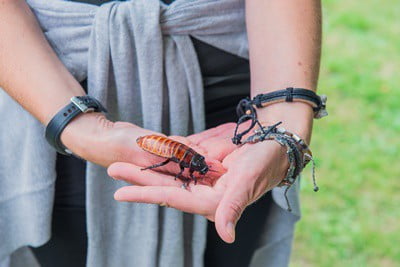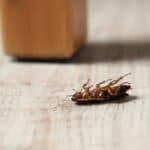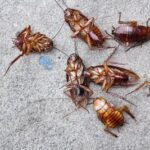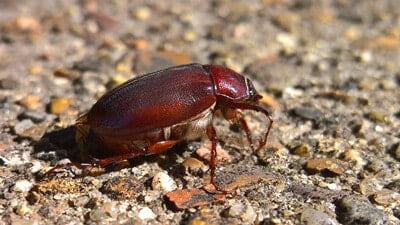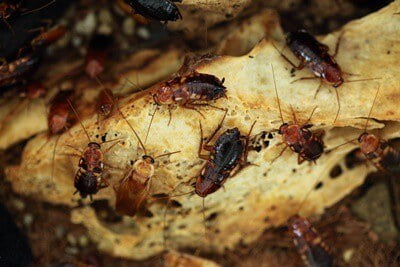Certain species of cockroaches can be housed in a tank and given food, bedding, controlled temperatures, and territory. In return, they’ll thrive and keep you company with their unique and interesting habits.
Cockroaches make good low-maintenance pets. The Madagascar hissing cockroach, the Indian domino cockroach, and the death’s head cockroach are popular choices due to their unique shapes, colors, movement, and behaviors. They make little noise, don’t smell bad, rarely bite, and require no social interaction.
Of course, not all types of cockroaches can be kept as pets. Pests commonly found in the wild or around your home are completely unsuitable. Only buy pet cockroaches from reputable breeders and exotic pet stores, and ensure that you have the right cage setup for your new pets.
Keeping Cockroaches As Pets
Exotic species, such as the Madagascar hissing cockroach, the Indian domino cockroach, and the death’s head cockroach, are bred and raised in captivity.
Are Pet Cockroaches Beginner-Friendly?
Cockroaches are one of the most durable creatures on the planet. If you feed them, give them water, and provide them with the right conditions, they can live for several years. You won’t find a more beginner-friendly pet.
These insects are extremely hardy. Don’t worry about forgetting to feed your cockroaches. According to the Journal of Economic Entomology, roaches can survive for up to 42 days without food.
If you’re concerned about getting the tank conditions wrong, fear not. Medical Entomology and Zoology have determined that cockroaches can survive refrigeration for as long as 40 days.
Cockroaches can’t swim. However, even if a cockroach falls into its water dish, it can hold its breath while submerged for up to 40 minutes. Cockroaches can even survive for long periods of time without a head. This will eventually kill the cockroach, but it’s a testament to their hardiness and durability.
What Do Pet Cockroaches Eat?
Cockroaches are omnivores that eat animal and plant matter. As extreme scavengers, they can digest rotting food. In short, cockroaches will eat nearly anything you offer them. There’s no danger that their diet will make them ill. Here’s a list of some of the foods that can be fed to pet cockroaches:
- Sliced orange
- Chicken
- Banana peel
- Monkey nuts
- Carrots
- Apples
- Smaller insects
- Grapes
- Pet food (dog and cat food)
- Sweet potato peel
- Rotten plant matter
- Sliced potato
How Long Do Pet Cockroaches Live?
From hatching to their natural deaths, pet cockroaches can live for up to 5 years.
Pet Cockroach Lifespan
| Species | Lifespan |
|---|---|
| Madagascar hissing cockroaches | 2-5 years |
| Indian domino cokroaches | Up to 2 years |
| Death’s head cockroaches | Up to 1 year |
Can You Play With A Pet Cockroach?
Roaches aren’t cuddly pets. However, some species are more comfortable being handled than others. For example, Madagascar hissing roaches are known for climbing and crawling around on their owner’s hands.
Do Cockroaches Bite?
Pet cockroaches can bite, but they rarely do. Like most insects, cockroaches have mandibles on the front of their body that allow them to break down food. These can clamp down on human skin for a soft bite. It won’t be too painful.
Cockroaches will only bite if they feel threatened and are unable to escape. To prevent defensive bites, you can spend more time with your pet cockroaches. Once they’re used to you and your smell, they may allow handling for longer periods. You can also wear thin gloves if you’re worried about nips and bites.
Wild roaches or those that infest homes are more exposed to bacteria, waste, and pesticides. Your pet cockroaches will be free from most of these dangers. Just wash and sterilize the area if you do get bitten.
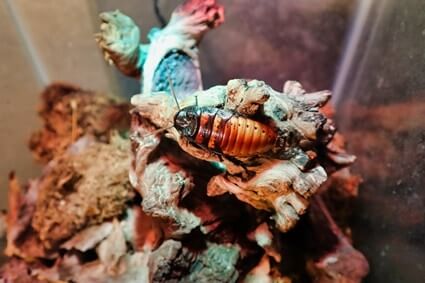
Do Madagascar Hissing Cockroaches Smell?
Madagascar hissing cockroaches don’t stink or smell bad. Even their poop doesn’t have a distinct or lasting odor.
Unlike pest varieties of cockroaches, you won’t find Madagascar hissing cockroaches crawling through drains and sewage systems. It’s also worth noting that cockroaches clean themselves with their antennae.
While all cockroaches produce pheromones, the odor is negligible to humans. Most people would describe the smell as musty and oily.
All cockroaches emit a smell when killed called the ‘death stench.’ This is oleic acid being released from the carcass as a warning to other cockroaches, instructing them to run away.
However, the death’s head cockroach will emit a mild odor when it’s startled. It’s not truly offensive, but you may wish to choose a different variety if you’re sensitive to foul smells and odors.
Do Cockroaches Make Noise?
Certain breeds of roach do make a distinct sound. In many wild species, this includes a soft chirping or squeaking. For the Madagascar hissing cockroach, it involves a signature hiss that sounds like an angry cat. For most other species of cockroaches, they make almost no sound at all.
Pet Cockroach Species
There are more than 4,500 cockroach species. Only 4 are considered household pests, and only 3 are kept as pets. What are the best cockroaches to own as pets?
Madagascar Hissing Cockroach
Madagascar hissing cockroaches (Gromphadorhina portentosa) hail from the island of Madagascar. They’re the most popular pet species of cockroach because of the loud hissing sound that they make.
As a non-climbing species, Madagascar hissing cockroaches cannot escape their tanks easily. They’re also completely wingless, so there’s no danger of them fluttering out of their enclosure. Males and females are capable of hissing, though it’s more common in males. This unique sound serves the following purposes:
- Warns members of their colony about incoming danger
- Defending territory and warning off rivals
- Scare away predators when threatened
- Attract mates and show off vitality and prowess
For owners that want to hear this interesting sound, you can gently nudge them and they’ll hiss at you. Madagascar hissing roaches are beloved for their size. They grow up to 2.9 inches in length and have a bulbous shape. They’re dark brown with gentle orange hues.
The most impressive part is the horns on the male’s head. The purpose of the horns is the same as with deer or rams. Rival males will slam against each other with their horns, hissing loudly to defend territory or mating rights. As you’d expect, this behavior makes adult males aggressive, especially toward other males.
Death’s Head Roach
The death’s head cockroach earns its name from the skull-shaped marking on its pronotum or head. This marking is a light brown, contrasted by the jet-black coloring that spreads across the rest of its body.
This look is capped off with jet-black wings, so the cockroach appears to don a cloak. It can grow up to 2 inches in size and be 1 inch wide. It may have prominent brown hues across its wings and body.
All cockroaches of the Blaberus craniifer breed can use their wings. So, keep your pets in a sealed tank with breathing holes. If your cockroach does escape, it won’t get far. The wings aren’t very agile and lack coordination, so they’ll flutter aimlessly around your home.
Regardless of what their ominous name implies, death’s head roaches are peaceful insects. They have even tempers and rarely show aggression, making them a good starter pet. Just watch out for the smell. When threatened, they will emit an odor. It’s not overwhelming and won’t upset the air quality of your home.
If left in their tank, they’ll bury themselves in the soil to hide. You’ll have to wait until they emerge before you can feet and handle your pets.
Indian Domino Cockroach
The Indian domino cockroach (Therea petiveriana) is named based on its distinctive markings:
- All-black body
- 7 white circles on the back. There are 3 circles on each side of the abdomen and 1 circle in the center
- Small legs
- Antennae on either side
- 3 cm in size
These 7 spots also give the roach its other names: the seven-spotted cockroach or the chess cockroach.
The Indian domino cockroach is a non-aggressive species. However, when in the nymph stage, they’re prone to biting and defending themselves against other cockroaches. The good news is that they quickly grow into docile adults.
The domino cockroach is far more active than any other pet cockroach. It will run around its tank and climb across any objects. If your tank isn’t secured with a well-fitted lid, it can sneak through the cracks it finds.
The domino roach has fully-formed wings shaped to fit its body, making them almost precise circles. However, this roach can’t fly. When it uses its wings, it’ll just glide or use its wings to jump short distances.
Pet Cockroach Care
Cockroaches are easy to keep as pets. By providing them with the right habitat, you can ensure that they live to their maximum life expectancy. They will also be happier and healthier, more willing to let you handle them.
What To Feed Pet Cockroaches
Cockroaches are low-maintenance pets, and this is best reflected in the food that they eat. Cockroaches can eat pretty much anything. Even still, quality food will ensure your cockroaches live a long life. Remember to feed them daily and remove food after 24 hours to avoid rotting.
Fresh Fruit And Veggies
The most nutritious and healthy foods you can give roaches are fresh fruits and veggies due to the large number of vitamins and minerals that they contain.
Cut the food into small pieces and set them in the cockroaches’ habitat. You can even take advantage of your pet’s scavenger abilities by feeding it overripe fruits that are too mushy for you to eat.
Leafy Greens
Leafy greens are a great source of fiber, as well as vitamins and minerals. All types of leafy greens will provide your cockroaches with a health boost. However, avoid iceberg lettuce because it contains too much water and has fewer nutrients than other leafy greens.
Pellet Food
Of course, your cockroaches will thrive on protein. This can be found in pellet form, taken from either cat food, dog food, or fish food. Moisten the pellets before giving them to your cockroaches, especially if they’re a small breed.
Water
Water should be available to your cockroaches at all times. It will only need to be replaced if it’s getting dirty.
Drowning is a possibility for roaches. Even if they can hold their breath for 40 minutes, they may struggle to escape the bowl. Be sure to provide water in a shallow dish filled with cotton wool.
To be safe, you can use water dispensers designed for small pets, like hamsters and gerbils. These dispensers are inverted, which removes the possibility of drowning.
Cockroach Setup
Cockroaches can be found all over the world, each with its own preferences in habitat and location. According to the International Journal of Pest Management, they are native to almost every region except Antarctica. In less extreme locations, cockroaches have been found to live among:
- Leaf litter
- Rotting vegetation
- Rotting wood
- Wood stumps
- Log piles
Some species are even known to not live on the forest floor but in trees and forest canopy. When housing your cockroaches, you need to mimic their natural habitats.
Enclosure Size
Cockroaches don’t need a lot of space. If you want to clearly view your pets, opt for a large tank with room to spread out any plants. Choose bigger tanks when you house multiple roaches because overcrowding may drive them to cannibalism.
- Large species, like the Madagascar hissing roach, will require 2.5 gallons for a group of 5 roaches
- For smaller species, you can get a 1-gallon tank
- Tall enclosures are recommended as cockroaches like to climb
Material
When keeping cockroaches, your main concern will be ensuring they don’t escape. Glass is the smoothest material, making it ideal for climbers. Since it will lack any pores or texture, your pets will struggle to scale the tank.
Tank Lids
For flying species, you will need a fine mesh covering. This will promote airflow while preventing any escapes.
Keep all edges of the lid pinned down securely. If the cockroaches are small, like with the domino breed, use a cloth or mesh sleeve to keep the enclosure sealed. This can be taped down on the edges to prevent any runaways.
Temperature
Your cockroaches will prefer temperatures ranging between 75 and 95 degrees F. The higher end of the spectrum will make them likely to breed and remain active.
To keep this consistent, it’s best to house your cockroaches in a heated room. For a more economical approach, you can use an electric heat pad. The pad should rest under the enclosure, covering only two-thirds of the bottom. This allows them to choose an area that they are most comfortable in.
Substrate
The substrate will be the most important part of keeping cockroaches.
For the death’s head cockroach, it will rely on the sediment to hide and feel safe. For hissing roaches, they will spend most of their time crawling along the ground. Even climbing roaches, like dominos, need a comfortable area to forage.
Here are the best types of substrate for pet roaches.
Wood Shaving
Wood shavings are a good choice for leaf litter species and burrowing types. There are many wood shavings that you can choose from in pet stores, often marketed toward small pets, like hamsters and rabbits.
You can safely use any but avoid cedar wood shavings. These can be toxic, and while your cockroaches will adapt, it may shorten their lifespan.
Coconut Fiber
Coconut fiber, also known as coir fiber, is the material harvested from the outer husk of an unripe coconut. This is a popular substrate for other pets, like bearded dragons and turtles.
Coconut fiber can also absorb moisture well, keeping the enclosure comfortably damp for your roaches. This material is perfect for species that like to dig or those most used to jungle habitats.
Dampened Sphagnum Moss
Sphagnum moss is a common substrate for reptiles, but it’s also a good choice for your cockroach pets. It’s designed to mimic decayed plant matter found on the forest floor, making it ideal for all roaches, especially leaf litter species.
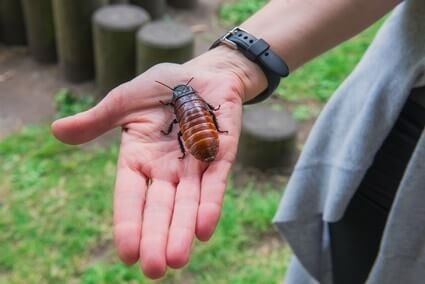
Plants Safe For Cockroaches
If you want to make your cockroach enclosure more appealing, you can transform it into a terrarium. There are many plants to choose from, and your cockroaches won’t mind the breed. As hardy creatures, they can digest nearly anything and will enjoy crawling all over the plant life.
Pothos
The pothos is a common houseplant because due to its hardiness in many conditions. This plant can easily withstand the high levels of moisture inside the enclosure. There are also many varieties you can choose from, the most common being the golden pothos.
When cared for, this plant will grow quickly. Your cockroaches will have plenty of leaves and vines to crawl over and explore. This plant will need bright, indirect light and shouldn’t be overwatered.
Boston Fern
This delicate-looking fern can thrive in moist environments and is very hardy. The small leaves of this plant also make it a fun playground for cockroaches.
Boston ferns need full shade and filtered light, so place them behind other plants. They should be watered weekly.
Croton
For those who want more eye-catching plants, the croton is ideal. It sports shiny, thick leaves of different colors and shapes, depending on the variety. This plant needs bright, indirect light and occasional watering.
One of the most popular types is the gold dust croton, which has golden specks on its deep green leaves. However, because of its size, this plant is better suited to larger enclosures.
Breeding Roaches
If you keep multiple cockroaches as pets, then breeding will soon follow. This is an effective way to renew the population of your enclosure or cultivate cockroaches as feeder insects for other pets.
However, depending on your state, you may need to secure a permit for breeding cockroaches. This rule varies from location to location and may cover only certain types of cockroaches. So, check your local regulations. Once you have the all-clear, here is the best way to care for baby roaches.
Baby Cockroaches
The Madagascar hissing cockroach produces about 60 eggs every 2 months. These are carried inside the mother with an internal ootheca. The ideal way to care for the babies is to keep the mother safe, warm, and well-fed.
For cockroaches that lay eggs around the tank, keep temperatures stable and avoid overcrowding. Cockroach eggs are hardy, so they won’t need much care. The biggest danger will be cannibalism from other cockroaches. As long as they’re well-fed and not stressed by overcrowding, they will let the eggs hatch in peace.
Nymphs
Nymphs don’t need to be moved after hatching. In fact, nymphs will grow much faster when in the presence of adult cockroaches. If possible, leave the newborns alone in the main tank because this will reduce stress in the colony.
You’ll only need to move nymphs to a separate tank if your enclosure is getting overcrowded. In this case, move them into a tank that is at least 18 x 18 x 18 inches in size. Once they reach adulthood, you’ll need to upgrade their large population to a bigger tank.
Nymphs will need different nutrients, depending on what nymphal stage they are in. However, this doesn’t mean that they require a special diet. In fact, cockroaches have the ability to self-select the food they need to gain all their required nutrients.
Instead of providing specific food, place a variety of high-nutrient food in the enclosure. This will allow the cockroaches to pick and choose at will. Good choices include fruits and vegetables, as well as high-protein foods.
Molting Roaches
For pet species, nymphs take about a year to grow to their full size. During this time, they’ll undergo multiple nymphal stages, with each stage ending with a molt. You’ll know that this process is underway if the cockroach’s body turns an opaque, milky white.
Molting roaches will move away from the more populated area of the enclosure to prevent injury. You don’t need to do anything at this stage. Don’t touch the cockroach. A molting cockroach will emerge on its own.
Why Are My Roaches Dying?
Mass die-offs are a scary thing for any pet owner. Despite their hardy nature, there are many reasons why cockroaches can die in large numbers. Look for these signs to eliminate the problem and get your roaches back in good health:
Toxic Chemicals
Toxicity is the leading cause of death in pet roaches. Toxic chemicals can come from anywhere, such as:
- Food. Any veggies, fruits, or plants sprayed with pesticides
- Unfiltered Water. This may contain harmful chemicals or chlorine, shortening their lifespan
- Plastic. Containers made of plastic or low-quality acrylic leak chemicals like BPA, which disrupt the endocrine system
Also, you may accidentally spread toxic chemicals around your cockroach’s enclosure, such as with:
- Flea powder
- Bleach
- Boric acid for cleaning purposes
- Old insect sprays to handle real pests in your home
Even pesticides that were sprayed months ago may still have a deadly effect on your cockroaches. Likewise, your neighbors may have been fumigating, spreading trace fumes into the home.
Environmental Factors
As durable as they are, cockroaches can fall victim to mold, bacteria, and fungus. In the wild, it’s one of the only ways that cockroaches can die. Because of that, check over your tank and see if there are any signs of growth.
If you find signs, remove all the affected roaches to a quarantine tank. Transfer the unaffected cockroaches to a new enclosure. If any of them die, remove them and sanitize the tank.
Pests And Disease
Before adding new cockroaches into your colony, check that they’re completely healthy. Any that show signs of illness or disease should be quarantined or disposed of. Watch out for:
- Damaged wings
- White spots
- Mites
The enclosure itself can also harbor pests that will kill your cockroaches. If you notice any ants, spiders, or other insects, remove them immediately. If you can find out how they got in, close off that entry points.
Can Cockroaches Live Alone?
Insects tend to be communal, and nearly all cockroach species are social insects. This means that they need to form a group or colony to be happy.
For this reason, entomologists recommend housing your cockroaches in a small group. You can keep 5 or more cockroaches in one enclosure, with 12-15 being a better number. As long as the tank is big enough to accommodate their population, your cockroaches will get along together well.
